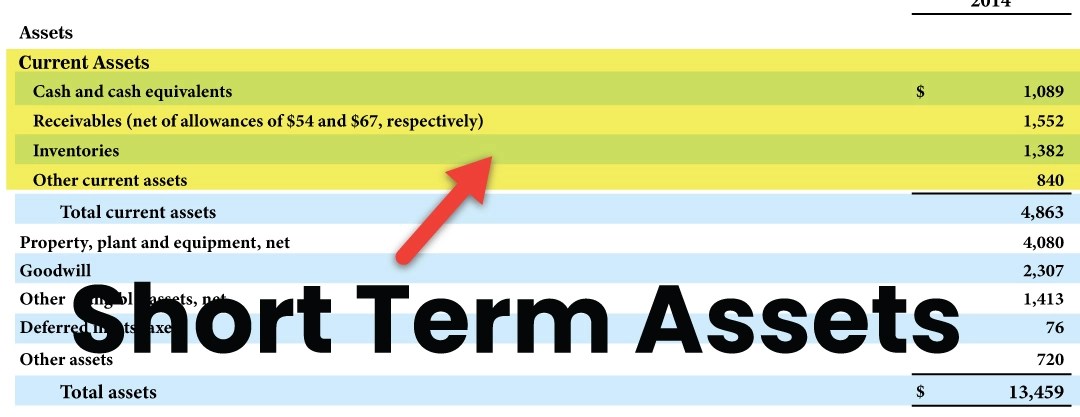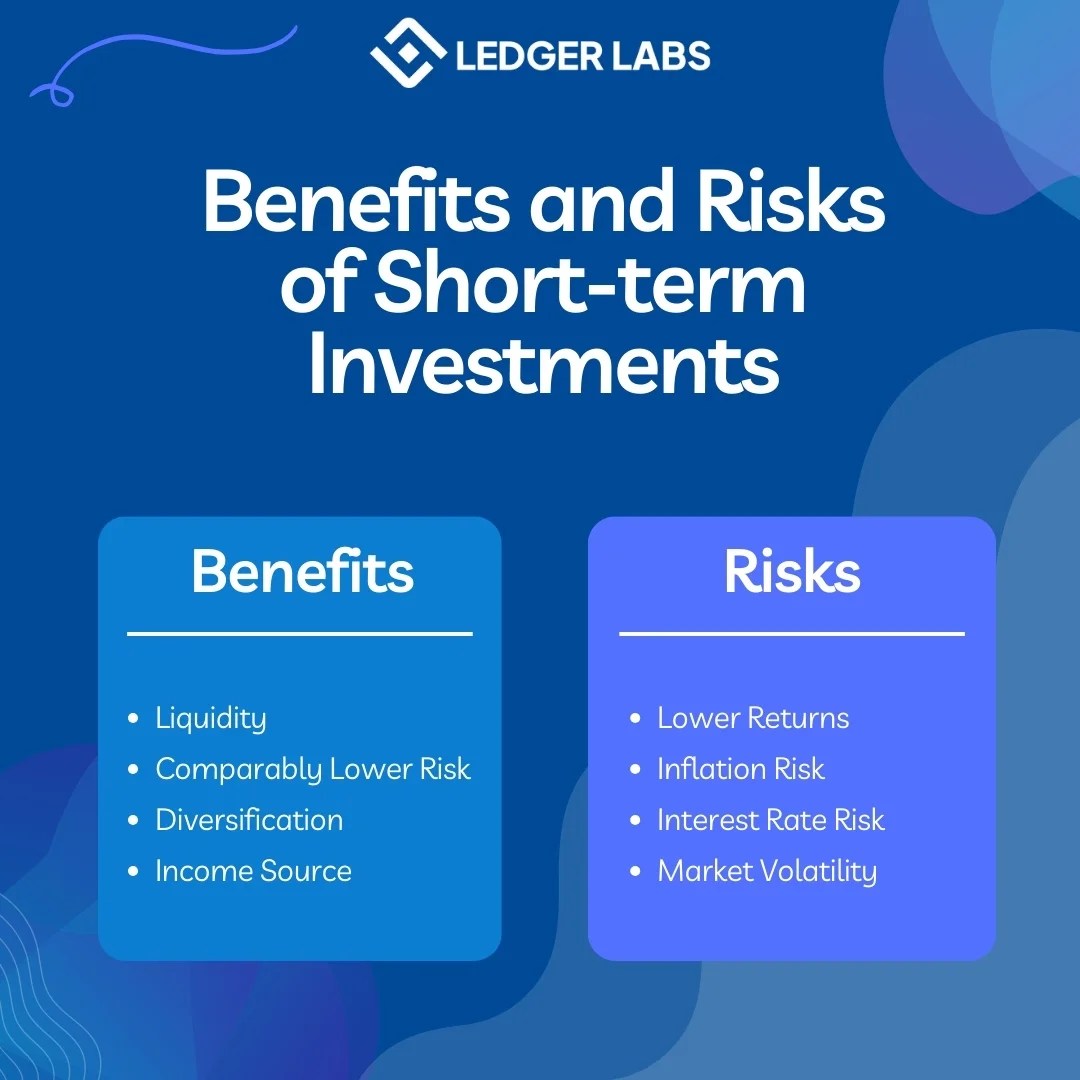- Services
- Netsuite ERP
- Tax Compliance
- Financial Controller
- Sectors
- Startups
- Manufacturing
- SAAS Accounting
- Professonal Services
- Real Estate Accounting
- How it Works
- Resources
- Blog
- Video
- Pricing
- About
- Our Story
- Contact Us
Get Free Audit
- Ledger Labs, Inc.
- Bookkeeping
- What are Short-Term Investments on your Balance Sheet?

- Gary Jain
- January 17, 2024
Table Of Index
Whether you are managing cash flow, or preparing for unpredictable expenses, short-term investments can offer the best balance to your company. In fact, it is a key strategy in smart financial management.
However, what are short-term investments? Well, simply put, short-term investments are the assets that a business can convert into cash in a very short period.
In fact, these are the investments that help businesses and individuals reduce the likelihood of risks. This makes it a fantastic deal on certain occasions. Short-term investments ensure you have ready-to-use cash when required, protecting it fromriskier ventures.
This choice is more appealing because businesses seek to manage their short-term cash requirements, while still earning a return.
Furthermore, with the Federal Reserve’s efforts to battle inflation, interest rates are actually more conducive than they have been for a while now. This, in turn, makes short-term investments quite the talk of the town and an attractive tool in terms of yields.
But hang on, what are they again? Where are they found? Better yet, how do you strategize your investments for the best outcomes? Read along to find out all about short-term investments from accounting experts. We’ll begin from thebeginning!
Short-term Investments Definition and its Types
Short-term investments are financial tools designed to be converted into cash or sold in a very short period, usually within around one year. Often known by the name of marketable securities or temporary investments, there are various short-term investments that are sold or converted to cash in just a period of three to twelve months.
Nevertheless, these are imperative components of a company’s financial plan that offer massive potential for quick returns while still maintaining liquidity. In fact, these are the types of investments that are especially attractive to people who want access to their funds on short notice, if need be.
Now, some of the major types of short-term investments include:
- Certificates of Deposit (CDs): Typically offered by banks, Certificates of Deposit or CDs yield higher interest rates since they usually need the depositor to lock their funds for a predetermined timeline. The time period ranges from a few months to five years. The FDIC insures these up to $250,000.
- U.S. Treasury Securities: There are a variety of government bonds available. The list includes Treasury bills, notes, floating-rate notes, and Treasury Inflation-Protected securities (TIPS).
- Money Market Accounts: These are FDIC-insured as well. Money market accounts usually offer higher returns than any traditional savings account does. But here’s the catch, it often comes with a minimum investment requirement. That said, you need to note one key area in this case. There is a clear distinction between money market accounts and money market mutual funds. The latter, in this case, is not FDIC-insured.
- Municipal Bonds: Municipal bonds typically come with attractive yields and tax benefits. That is because they are often exempt from federal income tax. Moreover, municipal bonds are issued by local or state governments, alongside other non-federal entities.
- Bond Funds: This is typically managed by professional investment companies or asset managers. Bond funds are most suitable for shorter-term investments. In addition, they do provide returns that are above average, but investors need to be more vigilant about the associated fees.
- Peer-to-Peer (P2P) Lending: This platform enables people to lend their surplus cash directly to the borrowers, helping a match between the lender and borrower.
- Roth IRAs: Roth IRAs are the individual retirement accounts that offer a flexible investment option with a lot of options you can go through. While contributions to a Roth IRA are always tax-free and penalty-free, earnings within the account are subject to specific requirements.
Need financial planning advice for your business from experts?
We’re here to help!
Get it now
Importance of Short-term Investments for Businesses
There are a variety of reasons why short-term investments can be life-changing for your business. Here are some major reasons why:
- a) Buffer against any financial obstacle: Short-term investments are best known to act as a lifeline or buffer during financial downturns and market uncertainties. These are, quite literally, the cushion against challenging moments.
- b) Risk mitigation: Short-term investments have the chance of lower volatility and are also less impacted by market fluctuations. This makes the choice a safe one for businesses that cannot afford to lose their operational capital.
Read more about Net Operating Working Capital here.
- c) Liquidity management: Short-term investments help maintain liquidity. Moreover, they enable businesses to get ready access to their cash for unanticipated expenditures or circ*mstances. Do you know why it’s rather important? That is because it is integral to managing daily operations, especially for businesses that often face seasonal cash flow fluctuations.
- d) Financial flexibility: Short-term investments are a great source of financial flexibility for different businesses. In simple words, they can be liquidated quite easily if the company abruptly needs cash for an unpredictable expense or experiences a sudden shortcoming.
What is an Example of a Short-term Investment?
Short-term investments can be best understood by an example:
Let’s consider Mike, a startup owner, who needed to settle a $6,000 debt in the next six months. Despite having a good income source, his day-to-day household expenditures left little to no space for him to allot this sum from his monthly income.
That being said, he started to invest in Certificates of Deposit (CDs) with a maturity timeline of four months. That was indeed a wise decision that yielded quite a few benefits.
As a result, after the amount matured, Mike received a sum of $8,000. He used this amount to clear off his debt and used the remaining to cover some mandatory business expenses.
Where does short-term investment go on a balance sheet?
If you look closely at a corporate balance sheet, you can easily spot short-term investment recorded in a separate account, typically listed in the current assets section. The short-term investments balance sheet can be located in this area mainly due to its liquid nature. This part of the balance sheet typically houses the assets that are expected to turn cash in a year. So, that brings us to the question:
Are short-term investments current assets?
There are many who face a slight confusion in this place. Well, the answer is yes. Short-term investments are considered current assets for accounting purposes. Now, if you ask us, what exactly are current assets? They are the assets that can be converted into cash in a year.

Benefits and Risks associated with Short-term Investments
Let’s discuss the benefits and risks of short-term investments:
Benefits
- a) Liquidity: Liquidity means you can quickly turn something into cash without losing value. This is primarily integral when you need to meet unpredictable expenses or seize a new investment opportunity. For investors who walk into the arena with short-term goals and need quick access to their money, this form of liquidity is a must-have. Do you know why? Because withdrawing this fund does not really come with massive penalties or losses.
- b) Comparably Lower Risk: Unlike long-term investments, these come with a lower risk rate. More often than not, short-term investments are mainly safeguarded from major market swings or financial downturns. More essentially, investors look at this as an incredibly cautious approach because it involves a lower chance of significant losses in the short run. As a well-rounded, risk-aware investing strategy, they play a vital role by providing a consistent income and aiding in capital preservation.
- c)Diversification: Diversification is a major point to note here. When you diversify your investments, it helps you spread out the risk. In other words, short-term investments are vital in this combination since they are known to move a little differently than long-term investments, like stocks. When you include these in your portfolio, you can strike a balance between risk and return. This is mainly advantageous during times of market uncertainty. This is especially crucial for business owners who want to preserve their capital while still making a living or who are almost at retirement age.
- d) Income Source: Short-term investments are an extremely reliable income source as they support interests and dividends. This is, in fact, a stable income flow that can complement other forms of earnings or be reinvested back into your portfolio. While these returns are a little lower than long-term investments, they do contribute to the growth of your overall portfolio. There are many who want to earn an income without having to risk their principal amount. Short-term investments are the answer to their needs! It’s a very practical choice if you want steady cash flow.

Risks
- a) Lower Returns: Short-term investments typically yield lower returns compared to long-term investments. That happens because short-term investments are not very risky and the timeline of investment is shorter. In case you are looking for better stability and need quick access to your funds, this might be a practical choice. However, if you are planning to build your wealth over a long period of time, you probably have to find other avenues. If you want to strike a balance in your portfolio, give preference to your risk appetite and financial goals.
Need help with setting up your financial goals?
Ask the experts!
Schedule now
- b) Inflation Risk: With inflation, the value of your money gradually falls down, that means the actual value of your short-term investments might actually plunge if the returns don’t surpass inflation. To preserve your purchasing power, look for short-term investments that offer returns greater than the rate of inflation at the moment.
- c) Interest Rate Risk: The value of short-term investments can undergo a shake due to changes in interest rates. This holds true, especially for fixed-income securities such as CDs and bonds. It is important to be a little more vigilant about interest rate trends and gradually start adjusting your investments to handle this risk efficiently.
- d) Market Volatility: While it’s true that short-term investments are usually more stable in nature, they are not completely free from the swings in the market. Your investments can still experience short-term fluctuations in its core value. You can manage these changes while protecting your capital and earning income if you have a well-diversified portfolio.
Strategies for Maximizing Returns on Short-term Investments
As a business owner, there are several strategies you can leverage for maximizing short-term investment returns, just like:
- a) Finding the right trade: Choosing a low risk trade is vital! This is where you need to carefully research the market to spot potential opportunities. Moreover, root out for the stocks that have an upward trend in their moving averages over 15-, 50-, 100-, and 200-day periods. Why do we say that? Because they might turn out to be good buying options! You need to closely look at market changes, trends, or business news that can affect stock prices.
- b) Real-time forex technique: This is where you generally speculate on currency price movements by utilizing technical indicators. This type of algorithmic trading uses advanced software to track and analyze real-time changes in currency exchange rates.
- c) Hedging risks: Hedging often eliminates the risks associated with an asset. Derivative financial tools, including futures, options, and swaps (which actually derive their value from an underlying asset) actually enable investors to safeguard against the likelihood of losses, thus insuring investments.
- d)Diversification: Try to diversify your investments as much as possible to balance your risk and returns. In other words, true diversification is all about combining your assets that are not related to one another. For example, invest in different industries rather than just one.
- e) Exhausted selling: Usually leveraged by day traders, exhausted selling is all about buying assets during times of panic selling. A recession scare is the biggest example of this scenario. Because panic selling may potentially lead to undervalued asset prices, there is still hope for profit when the market starts to correct.
The Importance of Regular Monitoring and Evaluation of Short-term Investments
Regular monitoring and evaluation of short-term investments is highly important for a number of reasons like:
- a) Market volatility: These investments are often subject to substantial fluctuations in the market. When you regularly monitor them, you can stay informed about these fluctuations. In turn, you can make on point decisions to maximize returns or minimize your losses.
- b) Risk management: Investors usually manage risk after they closely examine short-term investments. This actually helps them recognize any potential issues early on and take necessary measures to protect the investment.
- c) Performance tracking: When you consistently study your investments against your financial goals, it allows you to track its performance. This is actually quite helpful as it helps understand if your investment strategy needs a tweak.
In Wrapping up
The safety of short-term investments definitely comes with an attached cost. Unfortunately, you won’t be able to earn as much as you could have with long-term investments. However, there’s no doubt that short-term investments can be a good choice if you avoid the risk of loss. Short-term investments come with high liquidity and are one of the market’s favorites due to its low-risk investment nature.
But, let’s not forget that every investment has two sides to talk about. Each investment you consider will have a pro and a con. This makes it essential to consult those who know the nitty-gritty.
Are you confused about which choice fits your situation best? Get in touch with experts who have 12+ years of experience helping those with doubts about investment choices. Your job? Just schedule a discovery call!
FAQs
1. Are short-term investments assets or liabilities?
Short-term investments are usually categorized as assets on a company’s balance sheet. These are the types of assets that can be converted into cash or sold within a very short period of time. This indeed makes it an appealing choice for investors who don’t want the significant risk of suffering a loss anytime soon.
2. What are short-term, medium-term, and long-term investment?
You need to know how every investment term differs from the next. Short-term investments are usually held for just under a year and are often the perfect choice for immediate financial goals. This is for people who need immediate access to their money, if need be.
On the other hand, Medium-term is held between one to five years. They help maintain a balance between short-term holdings and the goal of settling for a long-term investment plan.
Long-term investments, in contrast, are pretty distinct from both of the above. It’s the legacy player in the game. It is held for over five years. More often than not, it aims at retirement and enables compound growth over time. In simple words, balancing short-term, medium-term, and long-term investment in your portfolio can help you diversify strategically.
3. Where can I invest for 6 months?
You can invest for 6 months in CDs, money market accounts, high-yield savings accounts, government bonds, or T-bills. All of these are short-term investments.
Don't forget to share the knowledge
Get a Free Consultation
Blog Categories
Automation
Starting Up
Bookkeeping
Tax Optimization
Strategic Finances
Managing Business
Related Posts
10 US GAAP Accounting Principles Simplified!
February 21, 2024
Gary Jain
What are 529 Plan Tax Benefits?
February 19, 2024
Gary Jain
How to Void a Check in Quickbooks
February 16, 2024
Gary Jain
6 Best Real Estate Accounting Software to Explore in 2024
February 14, 2024
Gary Jain
What is Payroll Tax? Calculation, Rates and Tips
February 12, 2024
Gary Jain
Tax Brackets 2024 and Income Tax Rates by IRS
February 9, 2024
Gary Jain
What is a financial audit and how to prepare for it?
February 5, 2024
Gary Jain
All about Net Income and Gross Income: Formula, Templates, Tips and more
January 31, 2024
Gary Jain
What are NetSuite Amortization Schedules and how to run them?
January 29, 2024
Gary Jain
The CFO’s Ready Reckoner for Credit Risk Management
January 26, 2024
Gary Jain
Our Services

Accounting & Bookkeeping Services
Accurate and timely accounting and bookkeeping to maximize ROI and spur growth.
Get Started

Controller Services
Build failproof processes that help you keep track of financials, compliances and more.
Get Started

Virtual CFO Services
Make solid data-backed decisions, reduce costs and achieve consistent growth.
Get Started

Tax Preparation and Tax Planning
The most thorough, efficient, and cost effective tax services you can get.
Get Started

NetSuite Accounting
Connect with an expert team that will plan, implement, and deliver NetSuite migration, set up and operation.
Get Started
Share the Knowledge
PrevPreviousNetSuite Fixed Asset Management Made Easy
NextHow to Login to Odoo 17Next
About Author
I help businesses Fix their Accounting Department in 45 days📅 without Bleeding Resources💰|| Added over 100M in bottomline of 500+ businesses || Focus on Relationships 🤝Custom Solutions💡Leveraging Technology + AI 📲💻
Instant Chat
Chat with our accountant instantly
Call Us
Call our toll free number for more insights
Schedule a Meeting
Book no-frills meeting with our experienced accountants
Email Us
Get immediate reply within a few hours from our accounting team
Subscribe to our newsletter
We publish fresh and power-packed insights every week on multiple platforms. Subscribe to our newsletter and get latest updates!
Quick Links
- How it Works
- Pricing
- About Us
- Sitemap
Services
- Bookkeeping
- CFO Services
- Tax Compliance
- ERP Accounting
- Controller Services
Blog Categories
- Start ups
- Automation
- Bookkeeping
- Tax Optimization
- Strategic Finances
- Managing Business
Latest Posts
10 US GAAP Accounting Principles Simplified!
What are 529 Plan Tax Benefits?
How to Void a Check in Quickbooks
6 Best Real Estate Accounting Software to Explore in 2024
Copyright © 2024 Ledger Labs, Inc. | Powered by Ledger Labs, Inc.
